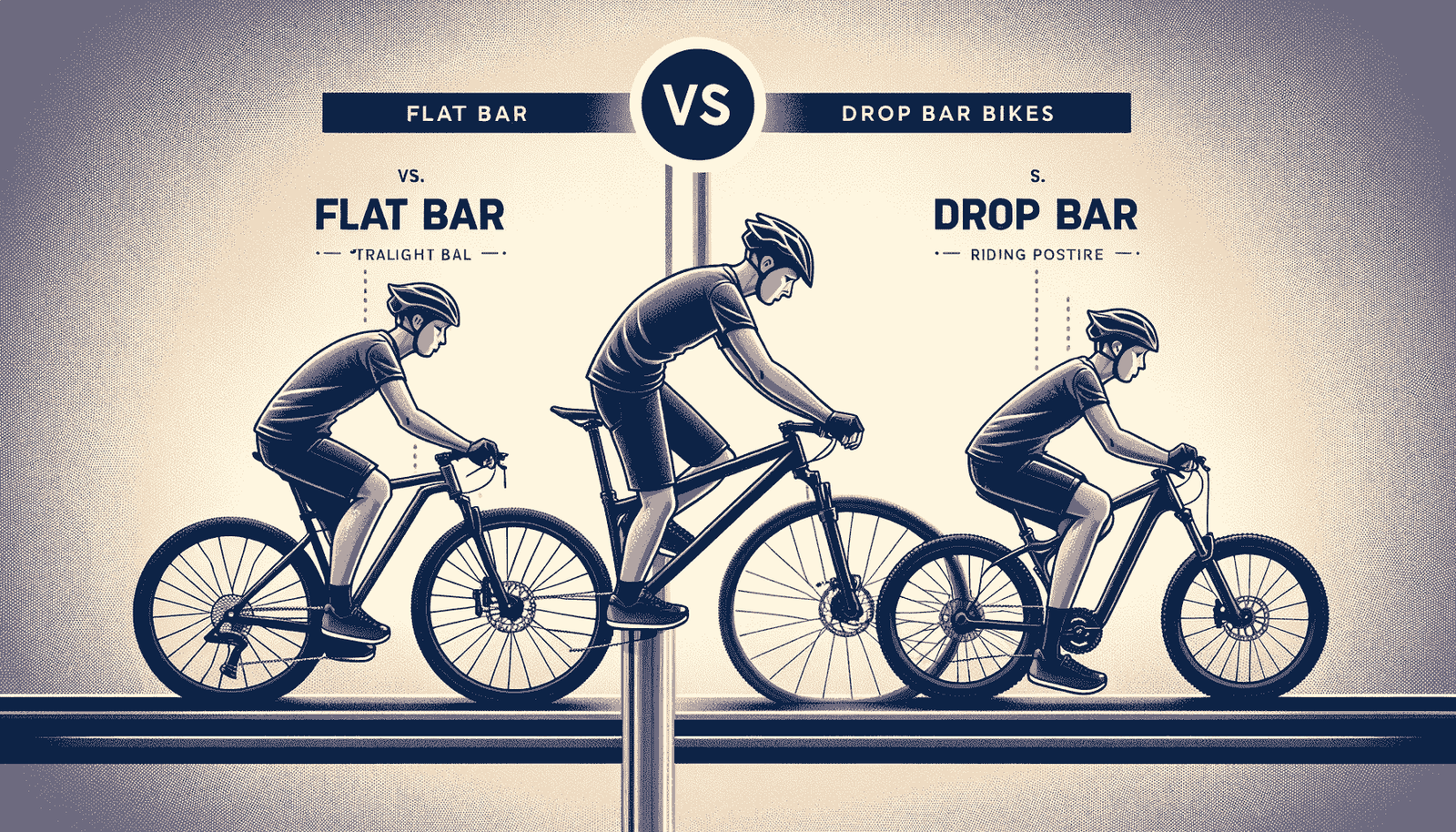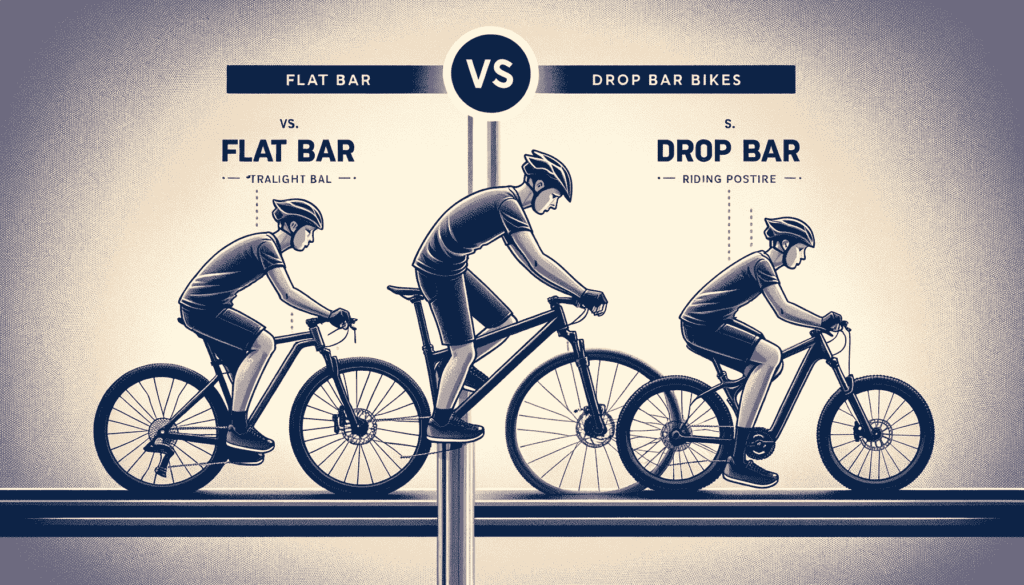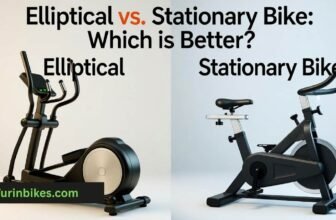
Choosing between a flat bar vs drop bar bikes can be a tough decision for any cyclist due to the comparison of drops. Each style has its own advantages and is suited to different riding experiences, including terrain, steering leverage, and comparison. While the flat bar offers a more upright and relaxed riding position, ideal for leisurely rides or urban commuting, the drop bar provides a more aerodynamic posture suitable for longer distances and higher speeds. The choice ultimately comes down to personal preference and intended use.
The bike’s flat bar offers better control in traffic or on busy city streets, while the drop bar excels in offering multiple hand positions
for tackling varying terrains during long rides. Understanding the distinctions between these two types of bikes, front position, and bar tape is crucial in making an informed decision that aligns with your cycling goals.

Flat Bar vs Drop Bar Bikes
Riding Position
Flat bar bikes offer much more comfort and better visibility in urban settings, with a more upright riding position and front visibility. On the other hand, drop bar bikes promote a more aerodynamic and aggressive posture, ideal for achieving higher speeds on open roads. For example, when commuting through city streets with frequent stops and starts, the upright position of flat bar bikes allows riders to easily navigate traffic and maintain awareness of their surroundings.
Preferred Usage
Flat bar bikes are generally favored much for commuting and leisurely rides due to their comfortable riding position and easy handling. Conversely, drop bar bikes are popular among road cyclists and long-distance riders who prioritize speed and efficiency over casual riding experiences. For instance, during long-distance rides or road races where maintaining high speeds is crucial, the aerodynamic posture provided by drop bars on a bike can significantly reduce wind resistance.
Control and Stability vs Speed
In urban environments with varying terrain and obstacles such as traffic lights or pedestrian crossings, flat bar bikes offer much better control and stability compared to drop bar bikes. The wider handlebars on the bike allow for more precise maneuvering through tight spaces while also providing an improved field of vision. Contrarily, on open roads where speed is essential for covering long distances efficiently or participating in competitive cycling events like triathlons or criterium races, drop bar bikes excel in maximizing speed potential due to their aerodynamic design.
Overall, flat bar bikes cater to commuters seeking comfort, ease of use, and control in bustling urban landscapes. Conversely, drop bar bikes appeal to avid cyclists pursuing speed, efficiency, and performance during long-distance rides or competitive racing events.
Frame Design Stability: Flat Bars vs. Drop Bars
Stability and Maneuverability
Flat bar bikes are known for their increased stability and maneuverability, making them ideal for navigating tight turns and executing quick stops. The frame design and bar tape of these bikes allows riders to maintain better control over the bike’s steering, especially in urban settings where sudden stops may be necessary. For example, when riding through crowded city streets or navigating busy intersections, the enhanced stability of flat bar bikes provides riders with a sense of confidence in their ability to navigate challenging situations.
On the other hand, drop bar bikes feature a more rigid frame design that prioritizes stability at high speeds. This characteristic makes drop bar bikes well-suited for descents and cornering maneuvers where maintaining control is crucial. While flat bar bikes excel in tight urban environments, drop bar bikes shine on open roads or during fast-paced rides where speed is a priority.
Riding Position Comfort
The geometry of flat bar bikes offers a relaxed riding position that reduces strain on the back and wrists. This comfortable posture promotes an enjoyable bike riding experience over long distances by minimizing discomfort commonly associated with extended periods of cycling. Riders looking for leisurely bike rides or commuting purposes often find the ergonomic design of flat bars to be highly appealing due to its emphasis on comfort.
Conversely, drop bar bikes promote a more aggressive posture that enhances power transfer while cycling. Although this bike positioning may not be as immediately comfortable as that offered by flat bars, it can benefit riders seeking maximum efficiency during competitive races or intense training sessions.
Brake Performance: Flat Bars vs. Drop Bars
Braking Systems
Flat bar bikes are typically equipped with linear pull or disc brakes, providing excellent stopping power and modulation. On the other hand, drop bar bikes often feature caliper or disc brakes, offering superior braking performance due to their increased leverage and mechanical advantage.
Flat bar bikes have the advantage of linear pull or disc brakes, which provide excellent stopping power and modulation. In contrast, drop bar bikes generally come with caliper or disc brakes, offering superior braking performance due to their increased leverage and mechanical advantage.
Lever Positioning
The brake lever positioning on flat bar bikes allows for quick access and easier modulation compared to drop bars. This makes bikes ideal for urban riding conditions where frequent stops are common. The rider’s hands being directly over the brake levers gives them better control on the bike in city traffic or when navigating through crowded areas.
In terms of lever positioning, flat bars on a bike allow for quick access and easier modulation compared to drop bars. This is particularly advantageous in urban riding conditions where frequent stops are common as riders can quickly reach the brake levers without changing hand positions.
Gear Ratios and Price Comparison: Flat Bars vs. Drop Bars
Gear Ratios
Flat bar bikes are equipped with wider gear ranges that feature lower ratios, enhancing their climbing capabilities and adaptability to various terrains. This means that when facing steep inclines or challenging off-road paths, the rider can pedal more easily due to the lower gear ratio, providing better leverage for conquering tough uphill sections. On the other hand, drop bar bikes typically have narrower gear ranges with higher ratios. These higher ratios optimize speed and efficiency on flatter surfaces or during sprints.
For example, imagine riding up a steep hill on a flat bar bike versus a drop bar bike – the wider gear range of the flat bar bike allows for easier pedaling and maneuvering in such demanding conditions. Conversely, when cruising along level roads or participating in sprint races, the narrower gear range of drop bar bikes enables riders to achieve greater speeds without excessive effort.
Price Comparison
In terms of cost comparison between flat bar bikes and drop bar bikes, it’s generally noted that flat bars are more affordable than their drop handlebar counterparts. The reason behind this lies in their simpler components and less specialized design compared to drop bars.
To illustrate this point further, consider how flat handlebars require fewer components such as brake levers and shifters compared to drop handlebars which often integrate complex systems like integrated brake/shift levers (brifters). Since flat bars cater more towards casual riders who prioritize comfort over aerodynamics or speed optimization found in road biking (which is associated with drop bars), they tend to be priced at a bit lower end of the spectrum.
Overall:
- Flat Bar Bikes: Wider gear ranges with lower ratios for better climbing capabilities.
- Drop Bar Bikes: Narrower gear ranges with higher ratios optimized for speed on flatter surfaces.
- Flat Bar Bikes: More affordable due to simpler components and less specialized design.
Closing Thoughts
So, when it boils down to choosing between flat bar and drop bar bikes, it’s crucial to consider your riding style and preferences. Flat bar bikes offer stability and control, making them perfect for urban commuting and leisurely rides. On the other hand, drop bar bikes provide aerodynamics and multiple hand positions, ideal for longer rides and speed. When making your decision, think about where and how you’ll be riding the most.
Now that you have a clearer understanding of the differences between flat bar and drop bar bikes, it’s time to hit the road and test them out for yourself. Take each one for a spin and pay attention to how they feel under your hands. Your personal experience will be the ultimate decider in this debate.
Flat Bar vs Drop Bar Bikes?
Flat bar bikes are suitable for casual rides and urban commuting, offering an upright riding position. On the other hand, drop bar bikes provide multiple hand positions, ideal for long-distance rides and aerodynamics.
Why Are Drop Bars Popular?
Drop bars are popular due to their versatility. They offer various hand positions that cater to different riding conditions like cruising on flats or tackling headwinds. The aerodynamic posture they facilitate can enhance speed and efficiency for longer rides.
Meet Sachin Kumar, an avid cyclist and bike enthusiast with a passion for two-wheeled adventures. At our Turinbikes site, Sachin shares expert insights, thrilling ride experiences, and tips for fellow bike lovers.






